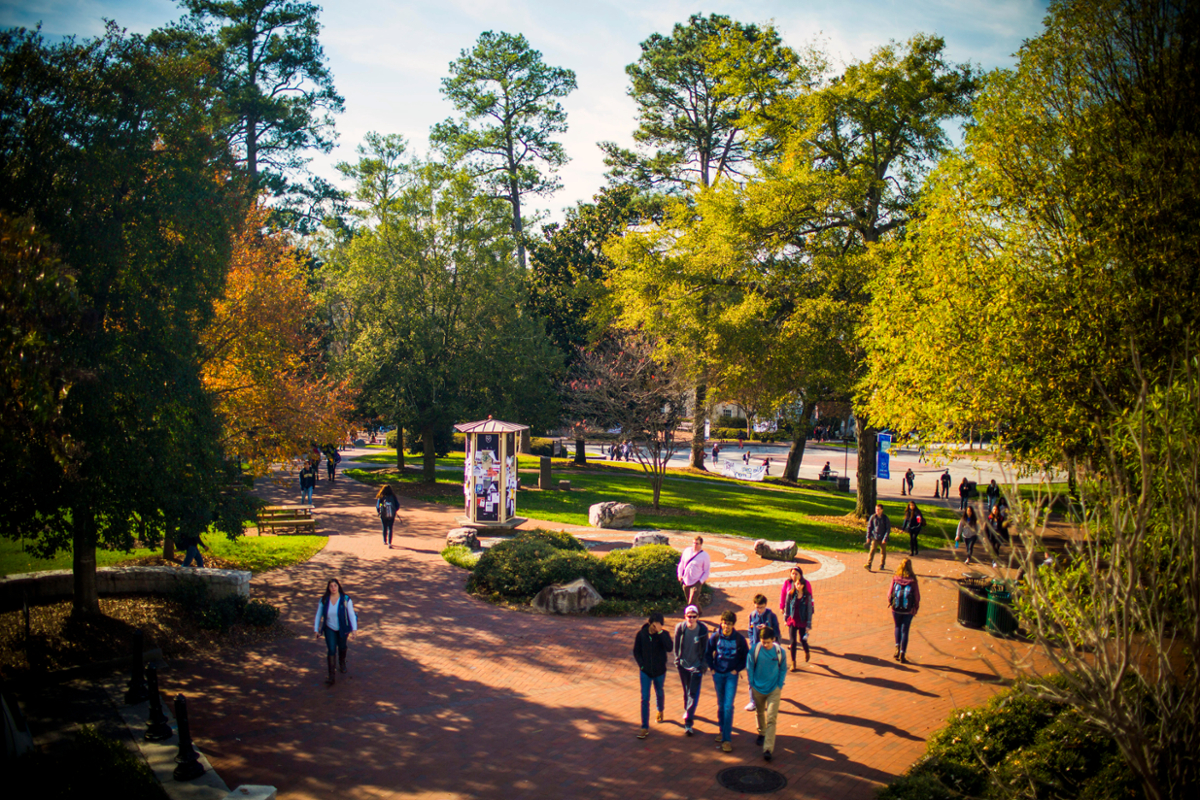“Surveys say that students and visitors make their impressions in the first five to ten minutes they’re on a campus, and those impressions last,” says Jimmy Powell, Emory’s director of exterior services, part of the facilities management team. “We tell our staff that when they see student visitors, they’re not going to class or back to their dorm. They’re going to park, see the grounds and probably use the bathroom. So if that’s a pleasant experience, they’ll leave with a good impression. If it starts out stressful in the parking deck, that’s hard to come back from.”
This honed-in focus is what drove the redesign of Dowman Drive and the main entrance to Emory’s Atlanta campus in the late 1990s and early 2000s — and that redesign eventually took root throughout the Atlanta campus.
The previous entrance to Dowman Drive.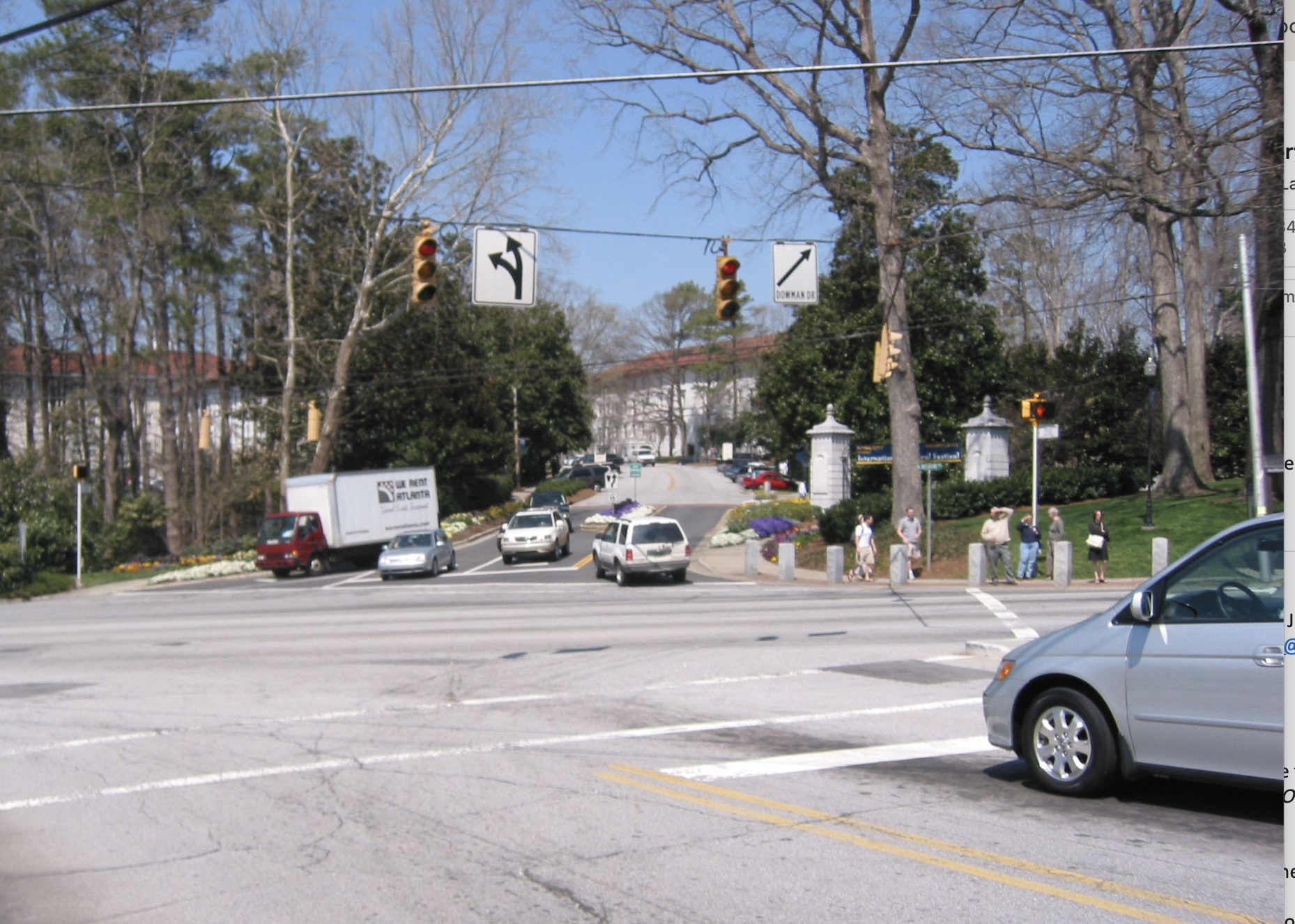
“That redesign has probably been my favorite project,” Johnson says, “because it truly changes how a visitor sees the campus for the first time.”
It’s also a top project for Powell. “The ‘open space’ projects of the late 1990s through the early 2000s transformed the campus from an urban jungle of parking and traffic to a more pleasant pedestrian environment in the central part of campus,” he says.
The environment students and visitors enjoy today is the culmination of multiple open space projects — and creativity — on behalf of the Office of Planning, Design and Construction (PDC) team.
Every design project is a group effort
Robin Lackey, university architect and senior director of project planning and design helps to guide Emory’s planning and design efforts. Lackey's team includes Johnson, along with numerous other professional design staff, including campus planners, space planners, interior designers, and environmental graphic designers.
PDC’s projects run the gamut. While the team manages the design and construction of massive endeavors like the new R. Randall Rollins Building, they are also managing dozens of larger-scale interior renovations and hundreds of smaller-scale projects, like outfitting a single office or creating new signage for a few spots around campus. Exterior of the R. Randall Rollins Building, which is LEED Gold Certified. 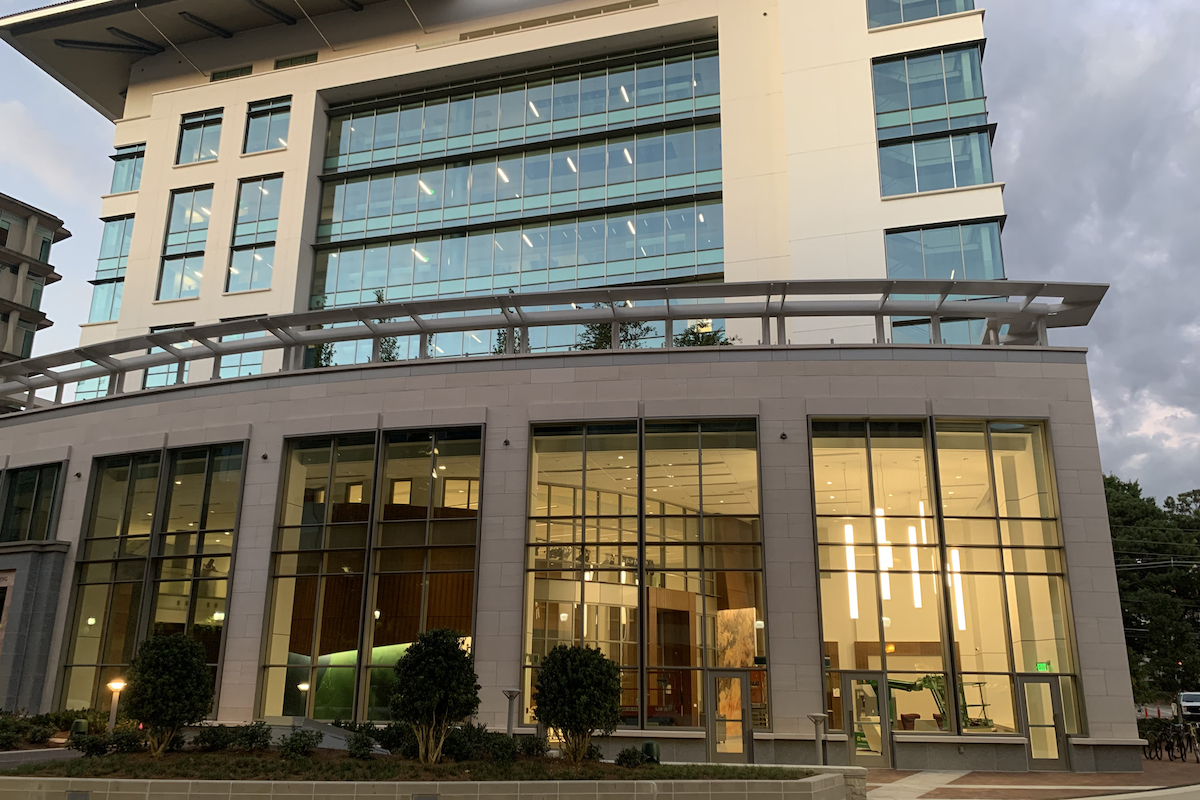
Large projects span multiple years — sometimes even before any actual ground is broken — but fall is the busy season for smaller projects’ design because spring brings permit applications for summer construction.
And no matter the project size, PDC is a team that learns new things every day.
“Everyone in our office has a high degree of expertise, but the nature of design and construction work is there are a billion tiny pieces that come together on every single project,” says Lackey. “So you might learn something about a strength of concrete you’ve never encountered, or a program you’ve never worked with before.”
Building a campus to withstand the test of time
When Lackey joined Emory in 2016, sustainability and accessibility were already top priorities. The biggest change she’s seen has been in the sustainability metrics used. In 2016, the industry standard was EUI, or energy use intensity — a numerical calculation that you wanted to push as low as possible.
Now, the focus has broadened to include carbon reduction, a more comprehensive approach. For each project, PDC considers the building and site requirements as well as the manufacturer of materials, how materials are transported and more.
Beyond what’s being built on campus, the team also considers what’s being planted.
A student walks through the Emory gate in the 1950s. 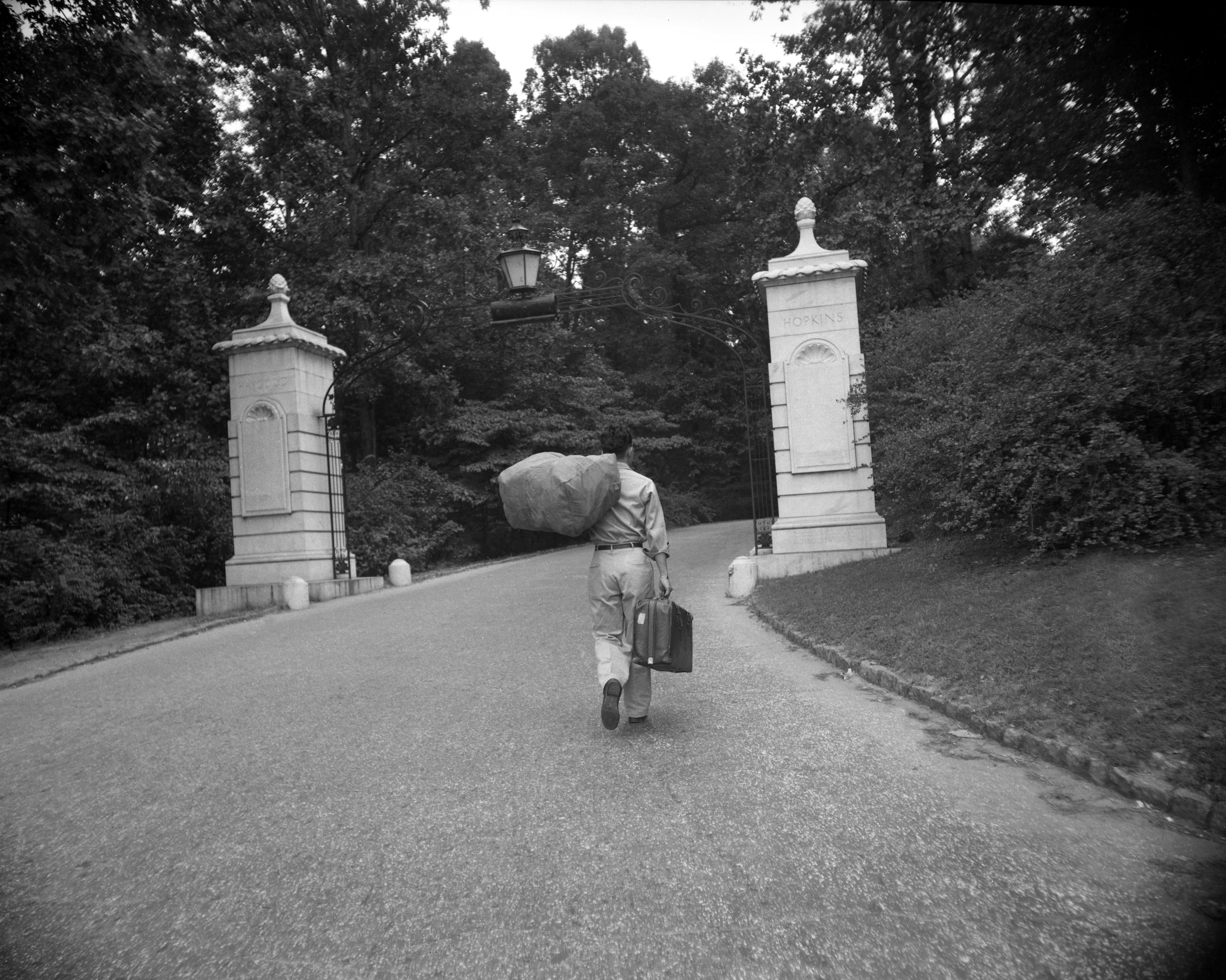
When Johnson joined Emory, campus adhered to the DeKalb County zoning code, which had less stringent language around tree replacement. At the urging of university leadership, the PDC team was tasked with creating a no net loss policy, and Johnson researched and wrote the guidelines.
“It’s a proud moment for me, even though we don’t use it as much now that Emory is within the city of Atlanta, which has a much more stringent code,” Johnson says. “We follow it to the letter and end up planting more trees than a typical project would.”
Using tree canopy acreage from 2006 as a benchmark, the goal of net gain is well ahead of the upcoming survey in fall 2024.
Part of working toward net gain requires removing invasive species that threaten native plants. The Campus Services FM Grounds Department manages the invasive species removal initiatives on campus and has eliminated acres upon acres of English ivy, Chinese privet, wisteria, kudzu and other species from campus over the last 25 years.
“We’ll never eliminate all of it, but we try to keep it at an acceptable level,” says Powell. “To this day, you’ll see big trees and you’ll see small, younger trees, but you won’t see many medium trees. That’s because they were choked out by invasive species.”
In addition to the removal of those species, Powell has been involved with starting the organic turf program on Lullwater House, banning the use of neonicotinoid pesticides — which get into the fluid of plants and are then transferred to pollinators — replacing turf with native plants and trees whenever possible, water conservation and limited use of pesticides and herbicides, among other efforts.
Although slow-going at times, these efforts have resulted in a more beautiful campus for everyone.
Where landscaping meets education
When thinking of “education,” classrooms are often the image that springs to mind. And for students who aren’t pursuing a career directly related to the environment, the need for pleasant, accessible outdoor spaces may seem like a bonus rather than a necessity.
But when the COVID-19 pandemic shook things up, Powell says outdoor spaces across campus were being used more than ever. “It’s kind of like everyone discovered the outdoors all of a sudden and wanted to be outside,” he laughs. “And campus became more WiFi accessible outside, too, which helps.”
One classroom has been outside and WiFi-free from the very beginning: the research greenhouse on campus and the educational gardens, both of which are managed by Erik Edwards.
While the greenhouse isn’t open for classes, it’s used to grow plants for research. Sometimes used in biology classes, the plants are primarily leveraged in research for environmental health and pharmacology. One crowd pleaser? Monarch butterflies.
Edwards works closely with Samuel C. Dobbs Professor Jaap de Roode in the department of biology, researching a parasite-host interaction that requires the rearing of butterflies — and milkweed to feed them. Edwards estimates that he grows 7,000-10,000 milkweed plants each year to feed the caterpillars that turn into adult monarch butterflies.
The educational gardens, however, are open to all students. Some volunteers come every week during their years at Emory, while others come two or three times a semester. And the harvest is shared, too. After each shift, volunteers can bring home any of the ripe produce.
Edwards explains that helping in the gardens doesn’t involve a strict schedule with requirements. “If you volunteer for an hour that week, you take what you want out of the garden.” Any produce that’s left over is donated, with this year’s main recipient being the Free Fridge located in front of North Decatur Presbyterian Church, at the corner of North Decatur Road and Scotts Boulevard.
Landscaping the rooftop garden at Emory Hospital Tower.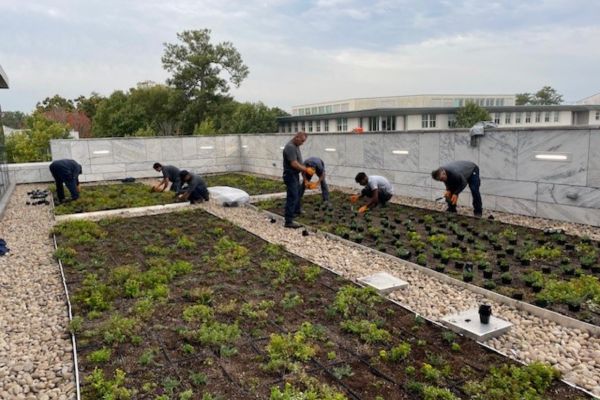
It also provides an opportunity for students to think critically about food sourcing and environmental impacts.
“The largest carbon footprint in your food is from the shipping,” Edwards says. “There’s nothing that involves less distribution and shipping than pulling it from your garden and taking it into your kitchen.”
Just as a garden undergoes seasons of change, Lackey is seeing the same thing happen to indoor spaces.
“None of us really knew for a few years how the post-pandemic world would shake out,” says Lackey. While the academic space doesn’t require much change, offices and administrative workspaces do.
“With hybrid work, we’re really starting to evaluate how we can increase our utilization of buildings we already have so that we can hopefully free up other spaces of other areas of the Emory mission.
“After all,” Lackey says, “the most sustainable building is the one you never built.”
A job that feels like home
Lackey points out that the spaces between buildings matter just as much as the spaces within those buildings — she calls it the magical thing about a university campus.
“Some of my favorite spaces aren’t the most architecturally unique,” she says, “but they really come alive when they’re by our community. For example, go into the libraries during finals week and you’ll see people huddled together studying, and to see that space come alive in a very unique, educational way is amazing.”
Edwards echoed a similar sentiment when it comes to campus beautification through the educational gardens.
“It won’t be traditionally beautiful in terms of a flower garden or a landscaped bed. But it adds a home beauty,” he says. “It provides a lot of good pollinators, which add beauty all over campus, and offers a color splash with the vegetables, too.”
Powell loves leading a dedicated and committed staff, as well as interacting with so many happy students and families during Commencement on the Quad. Despite the amount of work that goes into the event each year, staff get a unique vantage point to this celebratory day.
For Johnson, it’s all about counting rings.
“My favorite part is being able to get out and walk around campus as often as possible. Seeing a tree I know I planted 20 years ago, how big it’s grown and the impact that that is making.” Emory's present-day Atlanta campus, with landscaped areas and plenty of walkable paths for students and visitors. 